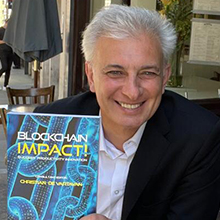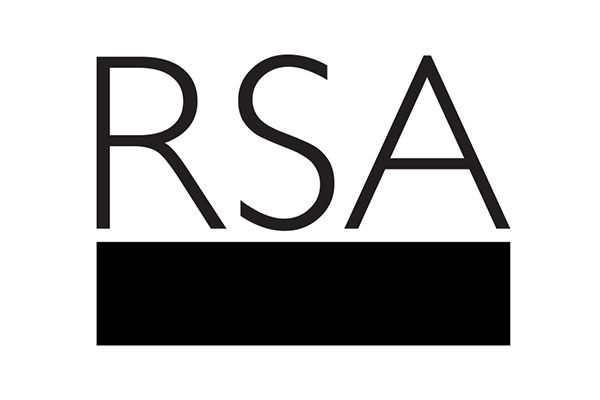Dr. Christian de Vartavan FRSA is co-author of what he believes to be the first printed book published on blockchain, and fully hashed (a function that meets the encrypted demands needed to solve for a blockchain computation). He shares his hopes for what this means for the future of publishing.
When our new book Blockchain Impact! was published in June, about 250 institutions, including many universities and technology institutes, were informed of the existence of the book by its publisher. It was with pleasure and pride that, as an RSA Fellow, I learned that the Society was the first to react, asking for a library copy (delivered the next day), suggesting a blog (you are reading it) and proposing that I give a talk about the book (in preparation). Ever since William Shipley established the Royal Society of Arts in 1754, it has been at the forefront detecting and promoting innovation that is good for society. I joined the RSA precisely because of its ability over the last 267 years to change society through technical and other innovations (Shipley was himself an inventor).
When I joined the RSA in 2018, I did not imagine that I would one day be myself the source of a technological innovation, which would benefit both the creative industries and the tech sector. As far as could be verified, Blockchain Impact! is the first printed book, the entire contents of which is not only hashed, but put on the blockchain by our publisher Projectis.
Hashing is simply passing some data through an encrypting algorithm, here SHA-256, that produces a string of mixed numbers and characters, called a hash. For a similar content, a text for example, the resulting hash generated by the calculating algorithm is always exactly the same. Change one comma of the text, and the resulting hash is completely different. The transfer of this text, or any content, to the blockchain is also expressed by a hash. In fact, every block of the blockchain is tied to the preceding one by a hash, and in some cases entire groups of blocks are hashed in a single hash so as to establish the immutability of the content on the blockchain record.
Digital versions of books were put on the blockchain in 2018 by online companies like Publica (now inactive) but we believe this has never been done for a printed paper book and/or by a traditional publisher since the invention of the Gutenberg press.
The back cover of the book shows not only the hash of the book’s contents but also the hash of its transfer onto the blockchain, as well as the block number and the precise date and time of the transfer. Why on the back cover and not in the imprint where it may have been more elegant to put such extensive information? Because should this information be added to the imprint and hence text of the book, then hashing this content again would produce another and completely different book hash.
The purpose of hashing a book’s contents is to protect intellectual property (IP). Once upon a time, authors and even publishers would send themselves by return mail the manuscript of a new book in a self-sealed envelope, to be only opened in case of litigation so as to prove anteriority of conception and establish copyright. Blockchain Impact! has not been put in an envelope, but should litigation on IP occur, a judge can now ask for the text of the book to be instantly hashed in front of the court by a computer specialist. Should the hash obtained be the same as indicated on the back cover, then the date-stamp equally indicated on the same back cover would be validated; the equivalent of the self-sealed envelope process, indicating when the book was finished.
The judge might then ask to retrieve the book’s block on the blockchain, which could equally be done by the same computer specialist in front of the court within minutes. Should anyone claim all or part of the book to be a plagiarism, this person will have to provide evidence of a date anterior to the date-stamp for each book.
This is not the only innovation Blockchain Impact! showcases to improve publishing. In May 2019 I answered a question set by Parliament’s APPG Blockchain: “How can blockchain empower creators in today’s digital era?” My response, reproduced in the book, I proposed that a new law be created to better protect authors’ royalties. The suggestion was that printers – not publishers – be compelled by law to record on the blockchain the number of copies printed. I suggested that publishers indicate the number of copies printed in the imprint of any book so that authors may more easily calculate their royalties. I am not aware of any UK publisher doing so although it does happen elsewhere in the world.
No doubt we will have to wait for printers to record the number of books printed or see a law compelling them to do so; in part because of the complexities involved in legislation. In the meantime, Blockchain Impact! indicates the number of copies printed, and all of Projectis’ future publications will bear this information.
Only time will tell whether these innovations and suggestions will set new industry standards in the UK or more widely. One thing is certain, they deliver a compelling proof point of blockchain itself, which is only at the cusp of its potential.
Christian is a scholar and writer and the Chief Executive of Projectis. He is a member of UK Parliament’s APPG-Blockchain and APPG-AI. He gave the UK Police's SIOs' (Senior Investigation Officers's) 2020 Blockchain Masterclass in Birmingham.
Related articles
-
Earth Day: why it needs to be every day
Comment
Phillip Ward
This year’s Earth Day focuses on plastic pollution. It’s a massive problem that must be addressed, but we need to go beyond one-day initiatives to instil a sense of urgency in responding to all the issues we face.
-
Making the most of your late career
Comment
Ann Thorpe
How do you harness your potential in the last chapter of your career? Ann Thorpe explains how the Late Career Alliance could help to craft your career narrative, impact and legacy.
-




Be the first to write a comment
Comments
Please login to post a comment or reply
Don't have an account? Click here to register.